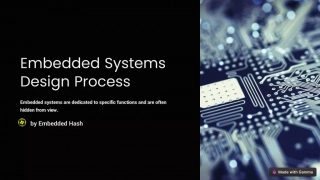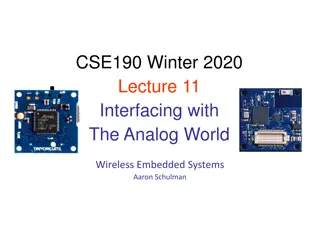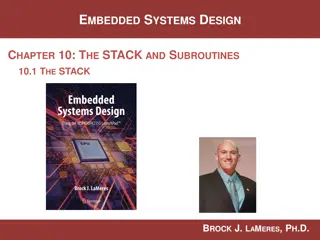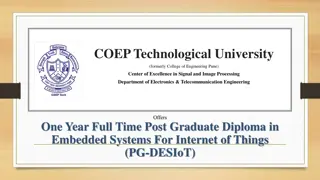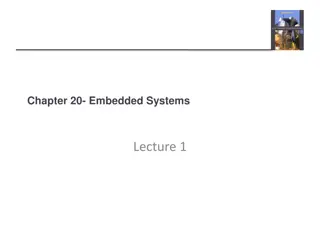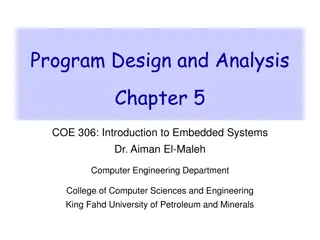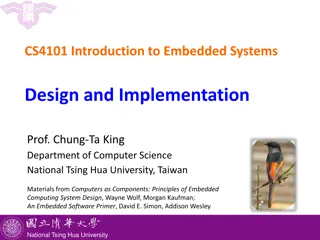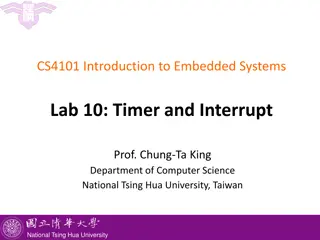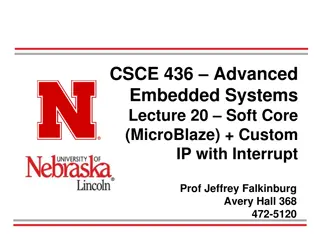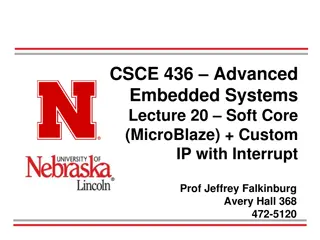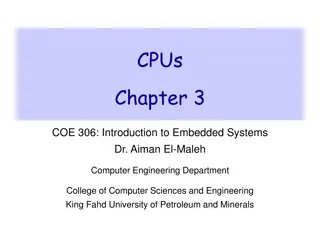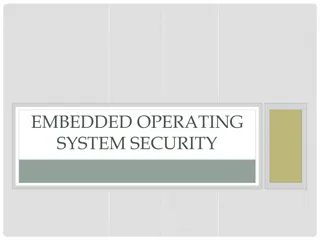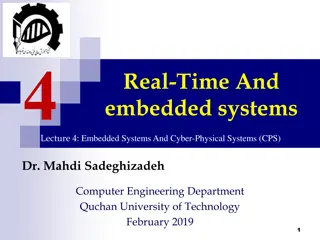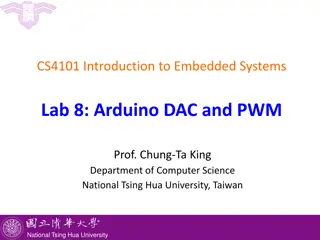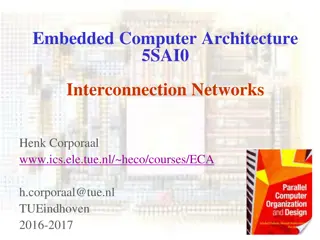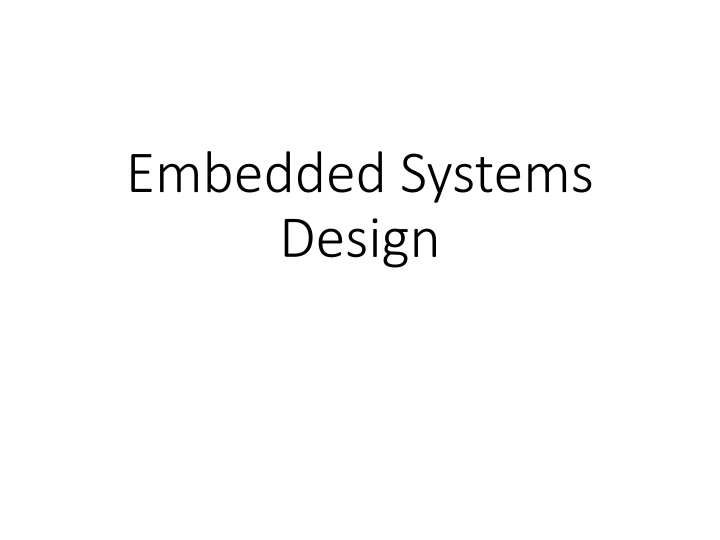
Optimizing Design Metrics in Embedded Systems
Explore the challenges, constraints, and key metrics involved in designing embedded systems. Learn about trade-offs, expertise requirements, and considerations for achieving optimal performance and cost-effectiveness in embedded system design.
Download Presentation

Please find below an Image/Link to download the presentation.
The content on the website is provided AS IS for your information and personal use only. It may not be sold, licensed, or shared on other websites without obtaining consent from the author. If you encounter any issues during the download, it is possible that the publisher has removed the file from their server.
You are allowed to download the files provided on this website for personal or commercial use, subject to the condition that they are used lawfully. All files are the property of their respective owners.
The content on the website is provided AS IS for your information and personal use only. It may not be sold, licensed, or shared on other websites without obtaining consent from the author.
E N D
Presentation Transcript
Embedded Systems Design
Design Constraints Slide credit P Koopman, CMU Introduction to Embedded Systems Setha Pan-ngum 2
Design Challenges Does it really work? Is the specification correct? Does the implementation meet the spec? How do we test for real-time characteristics? How do we test on real data? How do we work on the system? Observability, controllability? What is our development platform? Slide credit P Koopman, CMU More importantly optimising design metrics!! Introduction to Embedded Systems Setha Pan-ngum 3
Design Metrics Common metrics Unit cost: the monetary cost of manufacturing each copy of the system, excluding NRE cost NRE cost (Non-Recurring Engineering cost): The one-time monetary cost of designing the system Size: the physical space required by the system Performance: the execution time or throughput of the system Power: the amount of power consumed by the system Flexibility: the ability to change the functionality of the system without incurring heavy NRE cost Slide credit Vahid/Givargis, Embedded Systems Design: A Unified Hardware/Software Introduction Introduction to Embedded Systems Setha Pan-ngum 4
Design Metrics Common metrics (continued) Time-to-prototype: the time needed to build a working version of the system Time-to-market: the time required to develop a system to the point that it can be released and sold to customers Maintainability: the ability to modify the system after its initial release Correctness, safety, many more Slide credit Vahid/Givargis, Embedded Systems Design: A Unified Hardware/Software Introduction Introduction to Embedded Systems Setha Pan-ngum 5
Trade-off in Design Metrics Expertise with both software and hardware is needed to optimize design metrics Not just a hardware or software expert, as is common A designer must be comfortable with various technologies in order to choose the best for a given application and constraints Power Performance Size NRE cost Slide credit Vahid/Givargis, Embedded Systems Design: A Unified Hardware/Software Introduction Introduction to Embedded Systems Setha Pan-ngum 6
Time-to-market: a demanding design metric Time required to develop a product to the point it can be sold to customers Market window Period during which the product would have highest sales Average time-to-market constraint is about 8 months Delays can be costly Revenues ($) Time (months) Slide credit Vahid/Givargis, Embedded Systems Design: A Unified Hardware/Software Introduction Introduction to Embedded Systems Setha Pan-ngum 7
Losses due to delayed market entry Simplified revenue model Product life = 2W, peak at W Time of market entry defines a triangle, representing market penetration Triangle area equals revenue Loss The difference between the on-time and delayed triangle areas Peak revenue Peak revenue from delayed entry Revenues ($) On-time Market fall Market rise Delayed D W 2W Time On-time Delayed entry entry Slide credit Vahid/Givargis, Embedded Systems Design: A Unified Hardware/Software Introduction Introduction to Embedded Systems Setha Pan-ngum 8
Other Design Considerations Dependability Reliability: probability of system working correctly provided that it worked at time t=0 Maintainability: probability of system working correctly d time units after error occurred. [Some systems require no maintenance throughout their operating lives (e.g. electric kettles, computer keyboards), while some may need it such as mobile phones and airplane flight control (software upgrade)] Introduction to Embedded Systems Setha Pan-ngum 9
Other Design Considerations Dependability Availability: probability of system working at time t Safety Security: in communication Basically, critical applications have to operate correctly at all time e.g. airplane flight control computer. This includes both hardware and software aspects. Introduction to Embedded Systems Setha Pan-ngum 10
Example of System Fault 11 Slide credit B. Pahami
Other Design Considerations Operating environment Some engine Electronic Control Units (ECUs) in cars are located under the bonnets. So they have to work at high temperature, as well as dusty and wet environment. EMI (Electromagnetic Interference) Introduction to Embedded Systems Setha Pan-ngum 12
Real-Time Consideration Correct operation of real-time systems means: Working correctly (functionally correct) Producing outputs in time! i.e. correct result at the right time Introduction to Embedded Systems Setha Pan-ngum 13
Hard Real-time System designed to meet all deadlines A missed deadline is a design flaw For examples: ABS brake, nuclear reactor monitoring system System hardware (over) designed for worst-case performance System software rigorously tested Formal proofs used to guarantee timing correctness Slide credit T Givargis Introduction to Embedded Systems Setha Pan-ngum 14
Firm Real-time System designed to meet all deadlines, but occasional missed deadline is allowed Sometimes statistically quantified (e.g. 5% misses) For examples: multimedia systems System hardware designed for average case performance System software tested under average (ideal) conditions Slide credit T Givargis Introduction to Embedded Systems Setha Pan-ngum 15
Soft Real-time System designed to meet as many deadlines as possible Best effort to complete within specified time, but may be late For examples: network switch or router System hardware designed for average case performance System software tested under averaged (ideal) conditions Slide credit T Givargis Introduction to Embedded Systems Setha Pan-ngum 16
Deadlines Deadline : maximum time before a task must complete task time d The profit associated with execution of a task is after the deadline: Hard deadline: negative Firmdeadline: 0 (either make it or just don t do it) Soft deadline: decreasing with time soft d profit time firm hard Slide taken from J.J Lukkien Introduction to Embedded Systems Setha Pan-ngum 17
Levels of Embedded System Design Slide credit Ingo Sander Introduction to Embedded Systems Setha Pan-ngum 18
Design Abstraction Slide credit Ingo Sander Introduction to Embedded Systems Setha Pan-ngum 19
Abstraction Levels Slide credit Ingo Sander Introduction to Embedded Systems Setha Pan-ngum 20
Abstraction Levels Slide credit Ingo Sander Introduction to Embedded Systems Setha Pan-ngum 21
Abstraction Levels Slide credit Ingo Sander Introduction to Embedded Systems Setha Pan-ngum 22
Abstraction Level Slide credit Ingo Sander Introduction to Embedded Systems Setha Pan-ngum 23
Hardware vs Software Many functions can be done by software on a general purpose microprocessor OR by hardware on an application specific ICs (ASICs) For examples: game console graphic, PWM, PID control Leads to Hardware/Software Co-design concept Introduction to Embedded Systems Setha Pan-ngum 24
Hardware or Software? Where to place functionality? ex: A Sort algorithm Faster in hardware, but more expensive. More flexible in software but slower. Other examples? Must be able to explore these various trade-offs: Cost. Speed. Reliability. Form (size, weight, and power constraints.) Slide credit - W. McUmber, MSU Introduction to Embedded Systems Setha Pan-ngum 25
Hardware vs Software Workstations Personal Computers Graphics Processors DSP Processors Network Processors Power/Performance General-Purpose Processors FFT Processors MPEG Processors FIR Processors Embedded Domain-Specific Processors Embedded Application-Specific Processors Programmability and Flexibility Slide credit - Mike Schulte Introduction to Embedded Systems Setha Pan-ngum 26
Hardware vs Software Slide credit Ingo Sander Introduction to Embedded Systems Setha Pan-ngum 27
General-purpose processors Programmable device used in a variety of applications Also known as microprocessor Features Program memory General datapath with large register file and general ALU User benefits Low time-to-market and NRE costs High flexibility Pentium the most well-known, but there are hundreds of others Controller Datapath Control logic and State register Register file General ALU IR PC Program memory Data memory Assembly code for: total = 0 for i =1 to Slide credit Vahid/Givargis, Embedded Systems Design: A Unified Hardware/Software Introduction, 2000 Introduction to Embedded Systems Setha Pan-ngum 28
Single-purpose processors Digital circuit designed to execute exactly one program a.k.a. coprocessor, accelerator or peripheral Features Contains only the components needed to execute a single program No program memory Benefits Fast Low power Small size Datapath Controller Control logic index total State register + Data memory Slide credit Vahid/Givargis, Embedded Systems Design: A Unified Hardware/Software Introduction, 2000 Introduction to Embedded Systems Setha Pan-ngum 29
Application-specific processors Programmable processor optimized for a particular class of applications having common characteristics Compromise between general-purpose and single-purpose processors Features Program memory Optimized datapath Special functional units Benefits Some flexibility, good performance, size and power DSP Controller Datapath Control logic and State register Registers Custom ALU IR PC Data memory Program memory Assembly code for: total = 0 for i =1 to Slide credit Vahid/Givargis, Embedded Systems Design: A Unified Hardware/Software Introduction, 2000 Introduction to Embedded Systems Setha Pan-ngum 30
FPGA Architecture IOB IOB IOB IOB IOB CLB CLB IOB Wiring Channels IOB Programmable switch at wiring intersection (credit: www.wikipedia.com) CLB CLB IOB FPGA layout with Configurable Logic Blocks (CLB) and I/O Blocks (IOB) (credit: Katz s Contemporary Logic Design) Typical CLB (credit: www.wikipedia.com) Introduction to Embedded Systems Setha Pan-ngum 31
Highly constrained products tend to use application specific processors Many mobile phones (power&size constrained) contain ARM chips Hi-Fi (high performance&time constrained) contain DSP chips Introduction to Embedded Systems Setha Pan-ngum 32
Software Costs Slide credit P Koopman, CMU Introduction to Embedded Systems Setha Pan-ngum 33
Future Embedded Systems Slide credit P Koopman, CMU Introduction to Embedded Systems Setha Pan-ngum 34

